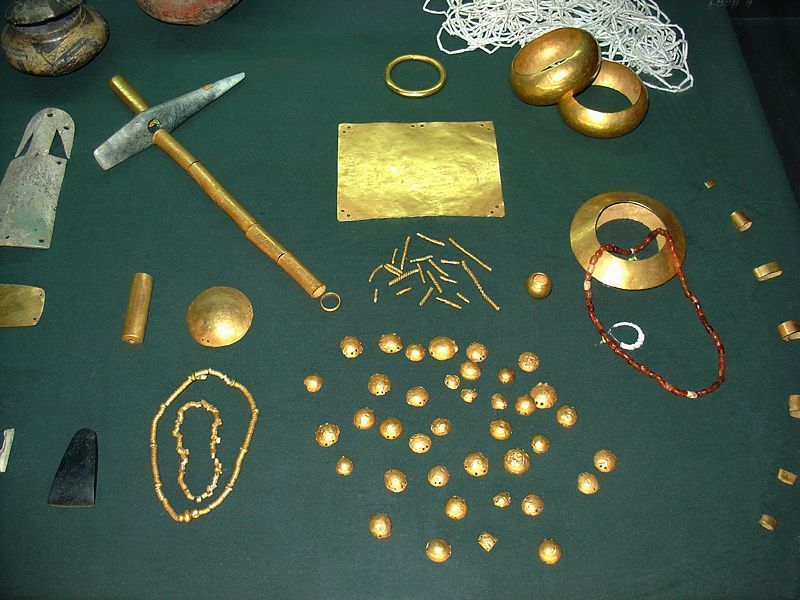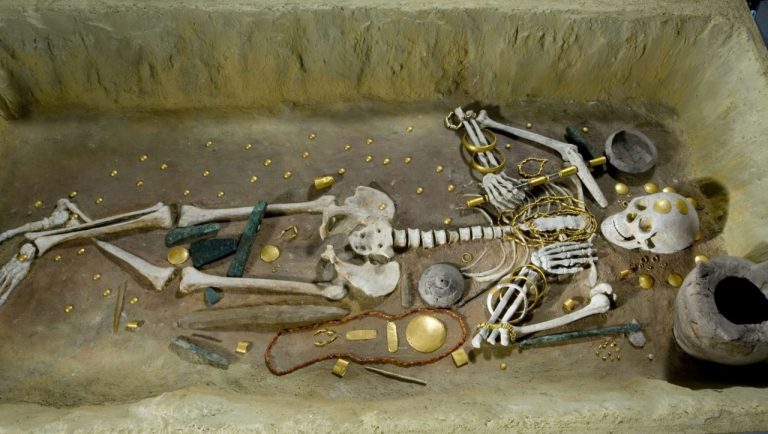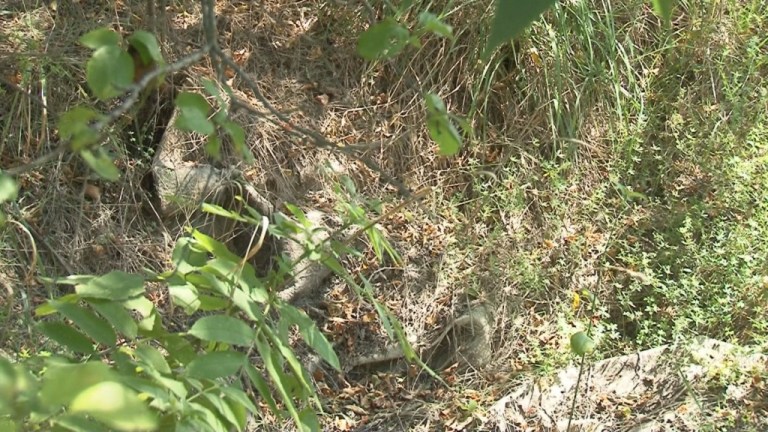THE “OLDEST GOLD OF MANKIND” WAS FOUND IN THE VARNA NECROPOLIS

The Varna Gold Treasure is considered the oldest gold treasure in the world or the oldest human processed gold in the world dating back to the time of the Chalcolithic (Aeneolithic, Copper Age) Varna Culture – 4,550-4,320 BC.

The Varna gold treasure all from the Late Chalcolithic period in the Varna 5th millennium BC, is one of five or six prehistoric gold treasures that were found in Bulgaria, that claim the title of “the oldest gold in the world”, that is, the oldest gold treasure or human processed gold.
The other prehistoric gold treasures of the same period are the Hotnitsa Gold Treasure, the Durankulak Gold Treasure, the gold artefacts of the Yunatsite Settlement Mound near Pazardzhik, the Sakar Gold Treasure, as well as gold items such as beads and jewels found in the Provadiya – Solnitsata (‘ The Salt Pit ‘) Settlement Mound.
The Varna Gold Treasure is often preferred for the title of “world’s oldest gold” Treasure because it is the largest of them.
All these treasures are the product of a first human civilization in Europe that has developed in the Neolithic and Chalcolithic period in today’s Bulgaria, and in the rest of the Balkan Peninsula, the Lower Danube region, and the West Black Sea coast, a prehistoric civilization referred to by some American scholars as “Old Europe”.


The Varna Gold Treasure was accidentally discovered in 1972 during the construction of a canning factory at the Varna Chalcolithic Necropolis.
It was the operator of an excavator, Raycho Marinov, then aged 22, who stumbled upon several artefacts, collected them in a shoe box, and took them to his home. A couple of days later he informed the local archaeologists.
For his discovery back then, Marinov was awarded BGN 500.00, a substantial sum for the time equaling several monthly salaries. However, the intelligence services of the Bulgarian communist regime followed him around for a while to make sure he had not kept any artefacts for himself in order to sell them.
In 2015, the Varna Gold Treasure was exhibited at the Parliament of the European Union in Brussels, and Marinov was invited as a special guest 43 years after he discovered the world’s oldest gold treasure by accident in his youth.


A total of 294 Chalcolithic graves were unearthed at the necropolis which was excavated by Bulgarian archaeologists Mihail Lazarov (in 1972–1976) and Ivan Ivanov (in 1972–1991). About 30% of the estimated territory of the necropolis is yet to be excavated.
Using radiocarbon dating, in 2006, the Chalcolithic graves where the Varna Gold Treasure was found were dated to 4,560-4,450 BC.
The discoveries from the necropolis indicate that the Varna Culture had trade relations with distant Black Sea and Mediterranean regions. It likely exported rock salt from the Provadiya – Solnitsata (“The Salt Pit”) rock salt mine.
The shells of the Mediterranean mollusk Spondylus found in the graves in the Varna Necropolis and at other Chalcolithic sites in Northern Bulgaria may have been used as a form of currency.
Among the graves, several featured a wealth of gold artefacts indicating that as early as the Chalcolithic the Balkan Peninsula (Southeast Europe) already had some form of statehood and a royal institution.
The gold artefacts from the Varna Chalcolithic Necropolis were found in graves with skeletons (mostly male) as well as in symbolic graves without human remains.
The Varna Gold Treasure includes over 3,000 gold artefacts categorized in 28 different types with a combined total of weight of 6.5 kilograms.
Over 5 kilograms of all gold artefacts have been found in a total of three symbolic graves plus Grave No. 43 which contains a skeleton of a man who might have been a ruler or king-priest.
Near the Varna Chalcolithic Necropolis but outside of it, archaeologists have discovered three other graves from an earlier period. These three graves are dated not to the Late but to the Middle Chalcolithic, closer to 5,000 BC. One of the graves contained a bracelet of gold cylinders on a string. The bracelet in question could be the world’s oldest human-made gold artefact.
One of the most interesting inventories was found in the so-called Grave No. 43 which was unearthed in the central part of the Varna Necropolis in 1974. It belonged to a male aged 40-45 but of rather a substantial size for the time, 1.70-1.75 meters tall (app. 5 feet 6 – 8 inches).
The numerous gold artefacts discovered in Grave No. 43 near Bulgaria’s Varna weigh a total of 1.5 kilograms. This rich inventory is one of the reasons to believe that the buried man was a very important member of his community, possibly a ruler or king-priest.
The gold items include 10 large appliques, a high number of rings some which were on strings, two necklaces, an item believed to be a gold phallus, beads, golden decorations for a bow, a stone ax and a copper ax with gold decorations, a bow with gold applications.


The funeral inventory also includes a large number copper artefacts such as a copper ax, a copper claw hammer, a copper chisel and a copper awl as well as lots of stone, flint, seashell, and bone artefacts including bracelets from the Spondylus mollusk, and 11 ornately decorated ceramic vessels.
In another grave of the Varna Chalcolithic Necropolis, Grave No. 36, a symbolic grave, the archaeologists found over 850 gold items – a tiara, earrings, a necklace, a breastplate, bracelets, a belt, a gold hammer-sceptre, a good model of a sickle, two gold lamellas representing animals, 30 models of heads of horned animals.
The artefacts were found covered with a gold-laced cloth. The gold items lined the contours of a human body with more artefacts on the right side which is deemed to signify that the grave contained a male funeral. The gold artefacts are interpreted as royal insignia.
Similar “royal” burials have also been found in graves No. 1, 4, and 5 of the Varna Chalcolithic Necropolis.
Another type of graves in the necropolis contains clay masks of human faces where the eyes, mouths, teeth, and noses are depicted with gold. Unlike the graves described above which contain smith tools, the graves with the mask contain clay vases, cups, and needles. That is why these are interpreted as female funerals depicting the Mother Goddess.
The closeness of the “female” symbolic graves No. 2, 3, and 15 with the symbolic royal graves No. 1, 4, and 5 are interpreted as ritual representations of holy marriages between a king and the Mother Goddess. These six funerals are believed to have been the core of the Chalcolithic Necropolis in Bulgaria’s Varna and to have predated the rest of the graves.





Much of the meaning of the finds from the Varna Chalcolithic Necropolis is seen as celebrating the role of the smith who in his role as a creator is seen as supplanting the role of the Great Mother Goddess transforming the matriarchal world into a patriarchal one.
The position of the smith in the Chalcolithic culture is seen as comparable to that of the king because during the Chalcolithic period metal was more of a status symbol than an economic means.